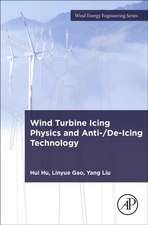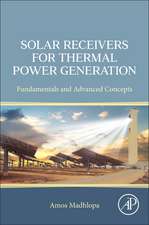Renewable Energy Utilization Using Underground Energy Systems: Lecture Notes in Energy, cartea 84
Autor Paweł Ocłońen Limba Engleză Paperback – 27 iun 2022
While the performance of energy systems which utilize heat transfer in the ground is not yet fully understood, this book attempts to make sense of them. It provides mathematical modeling fundaments, as well as experimental investigation for underground energy systems. The book shows detailed examples, with solution procedures. The solutions are based on the Finite Element Method and the Finite Volume Method. The book allows the reader to perform a detailed design of various underground energy systems, as well as enables them to study the economic aspects and energy efficiency of underground energy systems. Therefore, this text is of interest to researchers, students, and lecturers alike.
| Toate formatele și edițiile | Preț | Express |
|---|---|---|
| Paperback (1) | 939.46 lei 6-8 săpt. | |
| Springer International Publishing – 27 iun 2022 | 939.46 lei 6-8 săpt. | |
| Hardback (1) | 945.30 lei 6-8 săpt. | |
| Springer International Publishing – 26 iun 2021 | 945.30 lei 6-8 săpt. |
Din seria Lecture Notes in Energy
-
 Preț: 436.35 lei
Preț: 436.35 lei - 15%
 Preț: 655.60 lei
Preț: 655.60 lei - 18%
 Preț: 952.09 lei
Preț: 952.09 lei - 18%
 Preț: 1012.84 lei
Preț: 1012.84 lei - 15%
 Preț: 635.80 lei
Preț: 635.80 lei - 15%
 Preț: 645.96 lei
Preț: 645.96 lei - 15%
 Preț: 645.47 lei
Preț: 645.47 lei - 15%
 Preț: 640.06 lei
Preț: 640.06 lei - 15%
 Preț: 649.71 lei
Preț: 649.71 lei - 15%
 Preț: 643.84 lei
Preț: 643.84 lei - 18%
 Preț: 954.31 lei
Preț: 954.31 lei - 15%
 Preț: 643.84 lei
Preț: 643.84 lei - 18%
 Preț: 949.73 lei
Preț: 949.73 lei - 18%
 Preț: 1411.69 lei
Preț: 1411.69 lei - 15%
 Preț: 634.18 lei
Preț: 634.18 lei - 15%
 Preț: 649.87 lei
Preț: 649.87 lei - 15%
 Preț: 642.03 lei
Preț: 642.03 lei - 18%
 Preț: 957.62 lei
Preț: 957.62 lei - 15%
 Preț: 652.49 lei
Preț: 652.49 lei - 18%
 Preț: 963.15 lei
Preț: 963.15 lei -
 Preț: 361.03 lei
Preț: 361.03 lei -
 Preț: 391.79 lei
Preț: 391.79 lei - 15%
 Preț: 646.11 lei
Preț: 646.11 lei -
 Preț: 394.29 lei
Preț: 394.29 lei -
 Preț: 391.22 lei
Preț: 391.22 lei - 18%
 Preț: 954.45 lei
Preț: 954.45 lei - 18%
 Preț: 957.62 lei
Preț: 957.62 lei - 15%
 Preț: 647.27 lei
Preț: 647.27 lei - 18%
 Preț: 960.30 lei
Preț: 960.30 lei - 18%
 Preț: 1250.74 lei
Preț: 1250.74 lei - 15%
 Preț: 642.18 lei
Preț: 642.18 lei - 15%
 Preț: 639.41 lei
Preț: 639.41 lei -
 Preț: 488.71 lei
Preț: 488.71 lei - 18%
 Preț: 1677.21 lei
Preț: 1677.21 lei
Preț: 939.46 lei
Preț vechi: 1145.68 lei
-18% Nou
Puncte Express: 1409
Preț estimativ în valută:
179.77€ • 192.23$ • 149.89£
179.77€ • 192.23$ • 149.89£
Carte tipărită la comandă
Livrare economică 18 aprilie-02 mai
Preluare comenzi: 021 569.72.76
Specificații
ISBN-13: 9783030752309
ISBN-10: 3030752305
Ilustrații: XIV, 173 p. 134 illus., 127 illus. in color.
Dimensiuni: 155 x 235 mm
Greutate: 0.27 kg
Ediția:1st ed. 2021
Editura: Springer International Publishing
Colecția Springer
Seria Lecture Notes in Energy
Locul publicării:Cham, Switzerland
ISBN-10: 3030752305
Ilustrații: XIV, 173 p. 134 illus., 127 illus. in color.
Dimensiuni: 155 x 235 mm
Greutate: 0.27 kg
Ediția:1st ed. 2021
Editura: Springer International Publishing
Colecția Springer
Seria Lecture Notes in Energy
Locul publicării:Cham, Switzerland
Cuprins
Introduction.- Heat Transfer in Underground Power Cable Systems.- Economic Optimization of Underground Power Cable Systems.- Heat Transfer in Heating Networks.- Underground Thermal Energy Storage.- Summary.
Notă biografică
Paweł Ocłoń works as Associate Professor at Energy Department of Cracow University of Technology. His research area covers Renewable Energy, Heat Transfer, Energy Storage and Energy Efficiency. In last years he has co-authored over 60 ISI indexed papers. He is an Associate Editor of Journal of Cleaner Production, and the Co-Editor-in-Chief of Cleaner Engineering and Technology journal. He is also regular reviewer of many ISI indexed journals, as well as EU projects. He received a PhD Degree in Energy Engineering in 2013, DSc Degree in 2016 in Mechanical Engineering. From 2017 is employed as the Associate Professor at the Institute of Thermal Power Engineering. He received nationally recognized awards for his scientific achievements including the 1-st Degree Award for Scientific Achievements of the Ministry of Science and Higher Education of Poland, and the 3-year fellowship for Outstanding Young Scientists funded by the Ministry of Science and Higher Education of Poland. He isa coordinator of EU funded project RESHeat. He was also involved in over 20 projects in the area of energy systems, renewable energy and heat transfer.
Textul de pe ultima copertă
This book discusses heat transfer in underground energy systems. It covers a wide range of important and practical topics including the modeling and optimization of underground power cable systems, modeling of thermal energy storage systems utilizing waste heat from PV panels cooling. Modeling of PV pannels with cooling.
While the performance of energy systems which utilize heat transfer in the ground is not yet fully understood, this book attempts to make sense of them. It provides mathematical modeling fundaments, as well as experimental investigation for underground energy systems. The book shows detailed examples, with solution procedures. The solutions are based on the Finite Element Method and the Finite Volume Method. The book allows the reader to perform a detailed design of various underground energy systems, as well as enables them to study the economic aspects and energy efficiency of underground energy systems. Therefore, this text is of interest to researchers, students, and lecturers alike.
While the performance of energy systems which utilize heat transfer in the ground is not yet fully understood, this book attempts to make sense of them. It provides mathematical modeling fundaments, as well as experimental investigation for underground energy systems. The book shows detailed examples, with solution procedures. The solutions are based on the Finite Element Method and the Finite Volume Method. The book allows the reader to perform a detailed design of various underground energy systems, as well as enables them to study the economic aspects and energy efficiency of underground energy systems. Therefore, this text is of interest to researchers, students, and lecturers alike.
Caracteristici
Discusses the challenge of underground energy storage in a comprehensive manner Applies the Finite Element Method and Finite Volume Method to the modeling of underground heat transfer Discusses the modelling of PVT performance
























